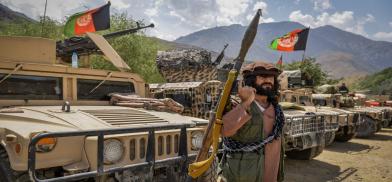Anti-Taliban resistance forces recapture four districts
The anti-Taliban resistance forces led by former Afghan first vice President Amrullah Saleh, who has recently declared himself as the acting president, launched counter attacks on the Taliban, capturing four districts in two provinces near Panjshir, the only province which is still not under the control of the Taliban

The anti-Taliban resistance forces led by former Afghan first vice President Amrullah Saleh, who has recently declared himself as the acting president, launched counter attacks on the Taliban, capturing four districts in two provinces near Panjshir, the only province which is still not under the control of the Taliban.
The resistance forces took control of Din Saleh, Andarab, Pul-e-Hisar districts in Eastern Baghlan province and Charikar in Parwan. FDD’s Long War Journal, which has been tracking the conflict for two decades, reported that these forces targeted the districts that control the important highway to the north.
Ahmad Massoud, the son of former famed legendary anti-Taliban commander Ahmad Shah Massoud, and Amrullah Saleh have been leading the resistance---they call it Resistance 2.0--against the Taliban. Saleh had refused to bow in front of the Taliban after the latter captured almost all of Afghanistan in a lightning offensive.
Reports indicated several special forces commandos of now collapsed the Afghan security forces are reaching to Panjshir to resist the Taliban. Saleh had also said he was talking to all regional leaders who are resisting the Taliban.
The resistance based in Panjshir remains the last bastion against the Taliban. The valley has never come under the Taliban's control, even in the 90s, when the Northern Alliance forces led by senior Massoud held the insurgent group of the valley.
Though many are calling it the Northern Alliance 2.O, experts remain apprehensive about its longevity, arguing the geopolitical situation with respect to neighboring countries has shifted decisively in favor of the Taliban.
In the 90s, it was the support from Iran, Russia, and India that helped the Northern Alliance to continue to resist the Taliban. Today all these countries, despite their own concerns, see the Taliban as the group which ended the twenty-year-long presence of Americans in the country: one of the major reasons these countries developed tactical relations with the Taliban.
Kabir Taneja, an expert and a fellow at New Delhi-based think tank Observer Research Foundation, writes in The Economic Times, “The power dynamics and requirements of regional states and their policies on the Afghan conflict have changed drastically...the geo-political dynamics as they stand today make it difficult for New Delhi to wedge itself in, making the prospect of a Northern Alliance 2.0 in short term even more difficult as a viable and realistic counter to the Taliban, and in effect, Pakistan.”
Similar views were expressed by C Christine Fair, another scholar on South-Asian politico-military affairs. In a Twitter thread, she wrote, "With Russia helping the Taliban, I doubt Tajikistan is going to be in the game. Without Tajikistan being in the game, how can India help?"
The Northern Alliance had used Tajikistan as its base in the 90s to receive foreign assistance.
Additionally, thousands of US-supplied heavy weapons seized by the Taliban from the Afghan security forces, now give them a decisive advantage to crush any future rebellion.
(SAM)









Post a Comment